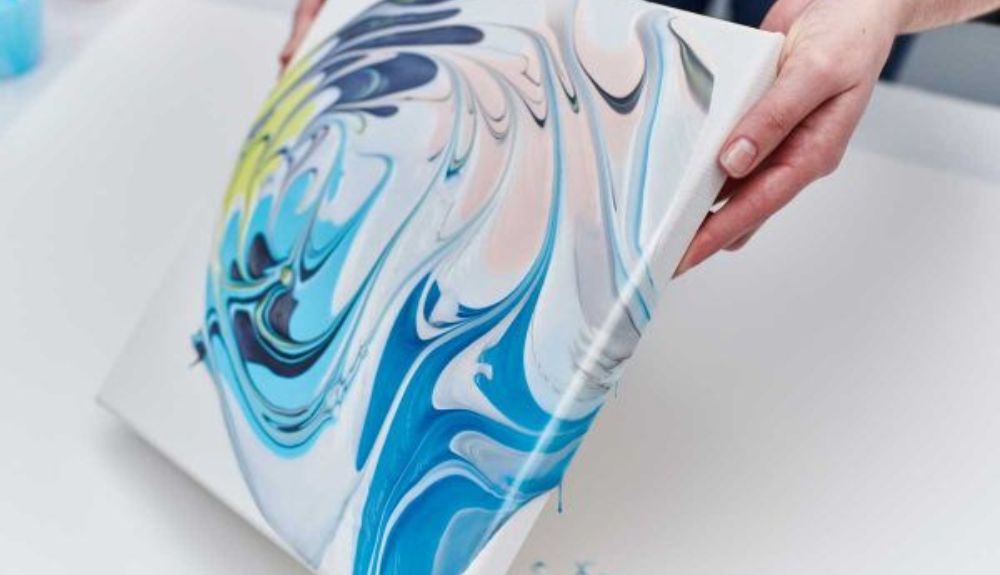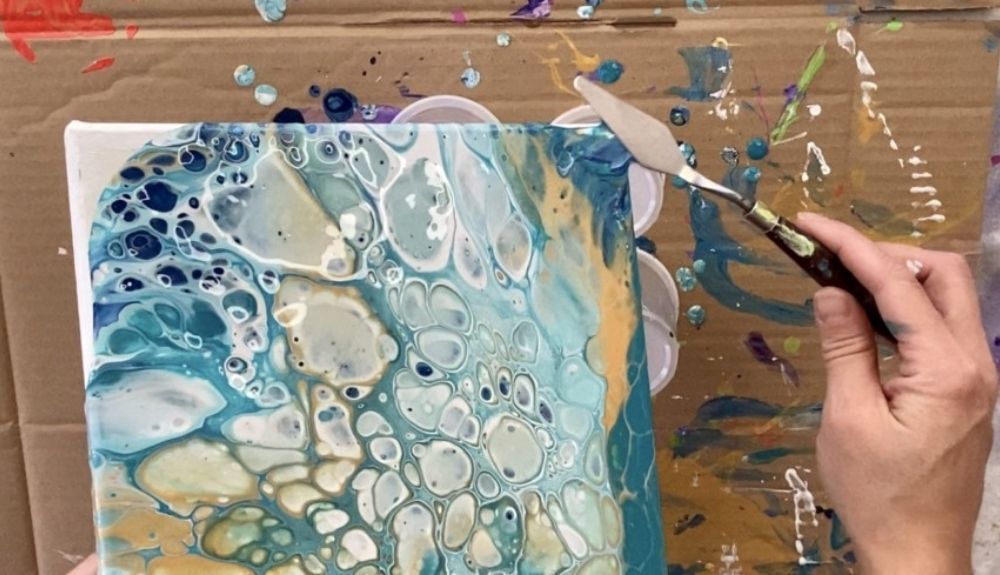Do Kind of Acrylic Paints Matter When Doing Pour Art
For many painting artists, besides watercolor painting, canvass painting with acrylic colors, and recently acrylic paint pouring has become a new unique trend that brings fantastic impressions in making art. And the almost common question we get related to making this art is "how to mix acrylic paint for pouring?" In this commodity, nosotros're going to show everything you need to know to obtain the perfect guide in acrylic paint for pouring no matter what levels y'all are.
What is acrylic pouring?

Acrylic pouring is a wonderful liquid painting method in which the acrylic pigment is poured into each other or tilted onto the canvas and disseminated by tilting the painting surface. To practise the acrylic pouring, acrylic pigment needs to be made liquid and pourable with the addition of a Pouring Medium and other ingredients equally needed. This liquefied pigment is then poured into each other or tilted onto the canvas and disseminated past tilting the painting surface, depending on the technique.
What materials do you demand for acrylic pouring?
Acrylic paints

They are the principal materials that you need to have for acrylic pigment pouring. The colour you choose is entirely upwards to you, but keep in mind the 'body' of the paint you lot use. The success of your pour will be adamant by the consistency of your acrylic paint. You can cull Liquitex professional acrylic inks to starting time. These extremely fluid colors comprise super-fine pigments suspended in a state-of-the-art emulsion. Quick-drying, permanent, water-resistant, and non-bottleneck, they're ideal for a variety of techniques.
Some other easy choice for beginners is Demco pro fluid acrylic paint which is made using the finest raw materials available, making these cocky-leveling paints and can be used every bit watercolor paints. Tri-Fine art Individual Rheotech Acrylic Paint is too a good pick since this student-grade acrylic paint besides has creamy and workable consistency. Besides, it has first-class adhesion and will not bit, crevice or split up in the jar.
Pouring Medium

Acrylic paint pouring medium is a material that aids in the consistency of acrylic paints by allowing them to flow more freely. Mixing acrylic paint pouring medium with acrylic paints transforms them, allowing you to brand wonderful acrylic pour art. Using a professional acrylic pouring medium rather than a less expensive option reduces the likelihood of flaws developing when your pour dries.
Liquitex Acrylic Pouring Medium is one of the most popular pouring mediums amidst artists which has a special formula that gives the most seamless results when used with pour painting techniques.
Painting Grounds

Acrylic pour painting can exist washed on virtually any flat surface that has been properly prepared for acrylic painting. Some artists prefer to work on traditional stretched canvases, while others choose easier-to-shop canvas boards or painting panels. However, the all-time pick to work with acrylic pouring paint should be Apollon Gotrick liquid fine art panel with basswood stretchers and painting surface made from Russian birch which is a hitting alternative to work of art on canvas. It is ideal for pouring medium and resin.
How to do acrylic paint pouring?
Prepare workspace

Prototype source: Acrylic Pour Techniques — A Guide on Different Fluid Painting Methods (fluid-painting.com)
Pour painting is messy, and information technology takes a few days for the paint to cure, and so the workspace needs to be well prepared earlier starting. You have to ensure a clean and dust-costless workspace to avert grit and pet hair getting into the moisture paint. Besides, you likewise accept to take a flat, sturdy surface which is required for the painting to dry smoothly. If you lot take pets or little children, you lot need a room with a door that tin can be airtight so they don't accidentally affect or tip your artwork.
Set pouring surfaces

As mentioned earlier, the canvass is now popularly used as a surface for pouring. You should choose the recommended 1 to exercise your pouring art to ensure the desired results. A small tip is to apply a coat of gesso (an acrylic primer if using an unprimed sail) to your canvas to brand information technology easier for the paint to adhere. Each awarding of gesso takes almost 45 minutes to dry, so start this project alee of time. Once the gesso is dry, y'all can cover the back of your canvas so information technology doesn't become coated with paint during the pouring procedure.
Mix your paints

Image source: How to Fix Acrylic Paint for Pouring – Left Brained Artist
Mixing acrylic paint for pouring needs a lot of patience and detail. You lot will learn how to mix acrylic pigment for pouring if you follow these steps. Firstly, put some acrylic paint in a cup or container of your choice, and then cascade in the aforementioned quantity or twice as much of the pouring medium, depending on the pouring medium used. Next, carefully combine all of the ingredients until they class a compatible acrylic mixture. It should have the consistency of liquid honey. If the acrylic mixture is too thin, add together additional water and stir everything together again. However, using besides much water can pause the acrylic polymer molecule and so it is recommended not to use more than thirty% of water in the mixture. If yous want your paintings to have cells, add together 1-2 drops of silicone oil and mix it in roughly. Finally, allow for some fourth dimension for any bubbles to rise to the surface of these mixes. If you commencement painting immediately, you'll end up with pockmarks all over the identify.
Start pouring
Artists are e'er experimenting and developing new pouring techniques. If y'all're just getting started, information technology's crucial to learn some fundamental techniques initially. There are 2 basic acrylic pouring techniques as follows:
Traditional pouring

Prototype source: The Beginners Guide to Acrylic Pouring — Ken Bromley Art Supplies
Gently cascade each color onto your canvas or board one at a fourth dimension. This method gives yous more than control over the placement of your color.
You can add splashes of colour wherever you retrieve the composition calls for them.
Selection upwardly the canvas later on you've applied your pigment and gently tilt it to encourage the paint to produce intriguing patterns and puddles. Allowing the paint to baste down the sides of your composition will give it a polished appearance.
Muddied Pouring

Take 1 clean paper cup and gradually layer colors from different cups into it. The way you lot cascade your paints into the cup will impact how they expect when they're poured onto your sheet. To run into how the location impacts your pores, try pouring colors down the inner side of the loving cup or straight into the center. The fashion it pours will differ depending on how quickly the color is introduced. If you add color to the cup too speedily, information technology volition sink to the lesser. The colour will settle at the top of the cup if y'all add it slowly. To make dissimilar sorts of pours, experiment with varied speeds and locations. Then, pour the colors straight onto the canvas from the cup. You can do this in any pattern you desire, equally long as the canvas is fairly as covered.
Pick up the canvas and carefully tilt it once all of the colors have been added. Tilting allows the paint to fill up in all of the gaps and can be utilized to create unique patterns.
Finish the edges

Prototype source: How To Do Acrylic Pouring — Step Past Step Tutorial For Beginners (stepbysteppainting.net)
Look effectually all iv borders for any areas that aren't painted. Smooth some pigment onto those portions with a palette knife or a woodcraft stick. Yous can use whatsoever leftover paint from your cups.
Don't stress about getting the edges perfect because, as seen in the photographs below, yous tin can apply touch-ups one time the painting is completely dry out.
FAQs
How to thin acrylic paint for pouring?
Unlike other types of painting, you lot can not mix acrylic paint with h2o to dilute it considering acrylic paint is water-soluble, significant that it is dissolved by water . Instead, you lot take to add together a pouring medium that volition help your paint flow while keeping the agglutinative properties of your paints .
Who did start acrylic pour painting?
In the 1930s, David Alfaro Siqueiros may accept been the inventor of Acrylic Pouring. He poured paint colors onto a canvas, and they flowed and blended in an unexpected design. And and so information technology has become a fantastic fine art technique until today.
Is it possible to sell acrylic cascade paintings?
There are several venues where yous may sell your acrylic cascade fine art, but it's non every bit uncomplicated as it appears. The majority of people are unaware of the time and resource required to create your acrylic pour paintings. Then practise it for the fun of creating, not for the sake of making money. Moreover, if you want to sell acrylic cascade paintings to potential art investors or collectors, you should choose advisedly professional materials. The low-quality products can result in cracking and peeling which diminish the painting's value over time.
Decision
In general, acrylic cascade painting is a 1-of-a-kind method that demonstrates the natural and artistic aspect of art. If you want to brand acrylic pour paintings, you lot'll need to know how to mix acrylic pigment for pouring. Information technology'south uncomplicated, but you'll need a lot of practise to master it. And in one case y'all've mastered the fundamentals, y'all'll be able to experiment with a variety of techniques.
Source: https://www.kingsframingandartgallery.com/blog/post/how-to-mix-acrylic-paint-for-pouring
Post a Comment for "Do Kind of Acrylic Paints Matter When Doing Pour Art"